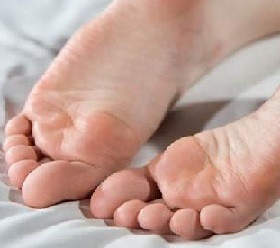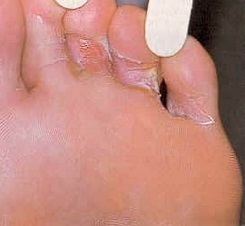 Foot fungus is a very common disease. According to statistics, about half of humanity in one form or another suffers from this ailment, because in the early stages of the disease itself does not manifest itself.
Foot fungus is a very common disease. According to statistics, about half of humanity in one form or another suffers from this ailment, because in the early stages of the disease itself does not manifest itself.
It is easy to catch it, just one contact with the source of infection. You can catch a foot fungus in someone else's bath, bath, cloakroom or taking advantage of other people's slippers.
The problem must be solved when the first symptoms are detected. For treatment use inexpensive, but effective drugs, they are able to overcome the foot fungus in a short time.
Causes
Infect the fungus only if it is in direct contact with it.
Most often this happens in public places: swimming pools, baths, saunas, locker rooms, especially when using someone else's shoes or walking barefoot. It is possible to transfer the fungus when using poorly disinfected instruments for pedicure.
Most people have strong immunity, coping with the disease. But there are certain factors thatcontribute to the appearance of fungus:
- Elderly age. Old people should be much more careful because of reduced immunity.
- Injuries to the skin of the feet. Through the open wounds, the fungus is much easier to penetrate into the human body, and begin to multiply actively. It is necessary to carefully monitor the condition of your feet for any damage to them. In case of detection it is necessary to carefully process the affected area.
- Use of shoes made of synthetic materials. In closed shoes, which sits on the foot very tightly, the feet sweat more actively. This leads to the creation of excellent conditions for the propagation of the pathogen of the fungus.
- The presence of immunodeficiency. It is observed in those who take long-term corticosteroids in HIV-infected people.
- Frequent and prolonged presence of feet in a damp and relatively warm environment (increased sweating, wet shoes, etc.). It is necessary to make sure that your feet are warm and dry.
- Walking barefoot (or in someone else's shoes) in sports clubs, swimming pools, saunas. The fungus is very tenacious; he can switch from the floor or someone else's shoes to the skin of your foot.
Most often, the fungus begins on the space between the toes, then spreads to the lower and lateral parts of the foot.
Signs of infection
The list of the first signs of the arisen foot fungus consists of:
- beginning of skin peeling;
- appearance of scales and thickening of the skin;
- occurrence of redness;
- the appearance of small vesicles with a saccharum;
- the appearance of different cracks on the skin between all the fingers;
- the occurrence of mild burning and itching.
It is worth remembering that each feature is shown individually, someone all at once, and someone has only one.
Symptoms of foot fungus
When there was a foot fungus, the symptoms are pronounced - itching and inflammation of the skin on the feet. The affected skin is scaly, cracking over time. In this case, the symptoms directly depend on which type of foot fungus is present.
- Whendeleted formdiseases in patients almost no complaints: itching almost does not bother. It is these patients that are often the source of infection for others.
- Intertriginous formfungus begins with moccasin, redness and swelling. On the skin over time, there are erosions, deep cracks, covered at the edges with scales. Patients are concerned about severe itching, pain and unpleasant odor.
- Hyperkeratotic form- represents infiltrated skin thickenings with definitely expressed mucovidnym peeling, observed in skin folds. It is accompanied by cornified, with cracks, patches, itching and dryness, appropriate discomfort. In rare cases - painful sensations.
- Dysgidrotic- is accompanied by the formation of small bubbles filled with transparent liquid that can be opened in case of severe inflammation, forming an eroded surface. With the disease of this form, peeling and flaking of the skin with severe itching, burning, swelling and even fever.
Based on the parasite fungus, the body's response can be the most diverse: from the reaction of the immune system to allergic reactions. Therefore, in order to understand how to cure the foot fungus, you first need to know its pathogen.
Stages of the disease
Before prescribing drugs, you need to determine the stage on which the foot fungus is located.
- The incubation period. The duration of this stage can vary in a fairly wide range - from 3 to 14 days.
- Stage of initial manifestations. During this period there is an itch stop, the skin turns red and slightly swells, small cracks are noted.
- The middle stage. On the skin there are spots that gradually grow, flake and itch.
- Extensive fungal infection. The process affects the nail on the leg, which loses its shine, dims, crumbles and deforms. The skin of the foot is stratified, deep, painful cracks appear.
If timely and effective treatment of mycosis of the feet is not performed, then after the onset of a short-term improvement, a relapse of the disease and a transition to a chronic form can occur.
How the foot fungus looks: photos
How to get rid?
Treatment of mycoses should begin with a diagnosis, because several types of fungi can attack the skin. They can be joined by a bacterial infection, which complicates therapy.
The doctor makes a survey, examining the skin under a special lamp and taking scrapings. After that, he will tell exactly what inexpensive but effective drugs to take for treatment, and also tell how long it will take to get rid of the fungus forever.
Treatment of foot fungus: ointments, cream, tablets
What are inexpensive, but effective drugs on the market? Let's consider more in detail. So, among the actual drugs that are represented in the pharmacy can be identified:
- tanactin (tolnaphthate);
- miconazole (mikatin).
- lamizil (terbinafine);
- Clotrimazole (лотримин);
All ointments and creams for the treatment of foot fungus are applied externally and applied only to the affected area.Stronger drugs, if the above listed did not give you the result:
- terbinafine or lamizil in tablets;
- Diflucan (fluconazole) in tablets;
- sporanox (itraconazole) in tablets;
- butenafine (mentax) ointment;
- naftin (naphthine) ointment.
In the case of severe foot fungus, systemic treatment is necessary, which will be prescribed only by a dermatologist, possibly in combination with folk remedies.
How to treat a foot fungus at home
 In a complex with medicinal preparations for the treatment of fungus use time-tested folk recipes, they are easy to use at home.
In a complex with medicinal preparations for the treatment of fungus use time-tested folk recipes, they are easy to use at home.
- One liter of boiling water pour four tablespoons of celandine grass and boil the broth for 3 minutes. You need to soar in this bath for half an hour. Take this bath for 3 weeks without missing a single day.
- Take the garlic and rub it on a grater or crush it in a garlic knife. Mix the garlic mass with an equal amount of butter. The resulting mass is used to lubricate the affected skin areas twice a day until complete recovery.
- At the initial stage of the disease sprinkle with soluble coffee cracks between the fingers and so walk. According to reviews, the fungus passes very quickly.
- Often, peppermint peppermint with salt is applied to the affected areas.
- Birch tar. Rip off the legs in soapy water, peel with pumice stone and smear tar. After 1.5 hours, erase the tar, do not wash your feet. After 2 days repeat the procedure. For a complete cure, 3-4 procedures are sufficient.
- Good results are provided by tea tree oil. Provided that the degree of damage to the skin of the legs is not strong. Usually the course of treatment lasts 3 months.
In parallel, the immune system should be taken up. She must be always on top. If the doctor considers it necessary, prescribe special physiotherapeutic procedures and antifungal therapy in the form of tablets.
Additional recommendations
To quickly cure foot fungus, pay attention to the following recommendations:
- Increased immunity: the intake of vitamins, immunostimulants.
- Treatment of the underlying disease, which weakens the body and creates a fertile soil for the onset of fungal infection. As such pathologies most often act as chronic infections, various skin diseases.
- The use of antibiotics when attached to fungal infection is bacterial.
As a rule, fungal lesions of feet do not pose a great danger to human health and life. But they have a chronic course, are a hotbed of inflammation, reduce immunity, and also lead to the appearance of allergic reactions.

How to choose probiotics for the intestine: a list of drugs.

Effective and inexpensive cough syrups for children and adults.

Modern non-steroidal anti-inflammatory drugs.

Review of tablets from the increased pressure of the new generation.
 Antiviral drugs are inexpensive and effective.
Antiviral drugs are inexpensive and effective.



